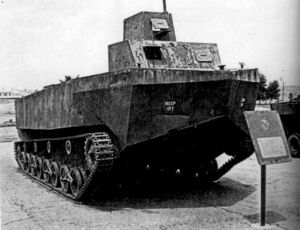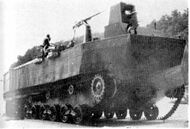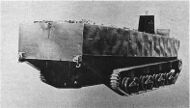Engineering:Type 4 Ka-Tsu
| Type 4 Ka-Tsu | |
|---|---|
 A Ka-Tsu on display | |
| Place of origin | Empire of Japan |
| Production history | |
| Designed | 1942–1943 |
| No. built | 49 |
| Specifications | |
| Mass | 16 tons[1] |
| Length | 11 m |
| Width | 4 m |
| Height | 2.25 m |
| Crew | 5 |
| Armour | 10 mm[1] |
Main armament | 2x torpedoes[2] |
Secondary armament | 2x 13 mm machine gun[1] |
| Engine | Gasoline engine in a water-tight pressure box 62 HP |
| Power/weight | 3 HP/1 ton |
| Suspension | - |
Operational range | - |
| Speed | (sea) 5 knots |
The special Type 4 Launch Ka-Tsu (特四式内火艇 カツ toku-yon-shiki uchibitei Ka-Tsu) was a Japanese amphibious landing craft of World War II. The first prototype was completed in late 1943 and trials were conducted off Kure in March 1944.
History
Japan's combat experience in the Solomon Islands in 1942 which revealed the difficulty of resupplying Japanese forces in such situations prompted the IJN to commence an amphibious tractor program in 1943, as the Ka-Tsu,[3] which was designed by Commander Hori Motoyoshi of the Kure Naval Yard.
Design
The Ka-Tsu's primary purpose was to transport cargo and/or troops ashore.[2] It had light armored shielding with a maximum of 10 mm.[1] Its engine compartment and electric final drives were hermetically sealed, as it was intended to be launched from a submarine.[3] The twin drive propeller shafts were designed to retract "into their ducts" once the vehicle reached the beach.[2]
The first prototype was completed in late 1943 and trials were conducted off Kure in March 1944.[3] By the time development had been completed, it was proposed that the Ka-Tsu be used to attack US battleships anchored in atolls (such as Ulithi), which could not readily be attacked using conventional means. It was proposed that a Ka-Tsu armed with a pair of torpedoes be dropped off by submarine away from the atoll, propel itself to the outer reef using its tracks, and then enter the lagoon on the inside of the reef. Tests were successfully carried out with a modified Ka-Tsu carrying two torpedoes on its deck, but the war ended before any such mission could be mounted and the Ka-Tsu deployed in combat.[3] A total of 49 units were produced.[1]
See also
- Blockade Runner
- Type 3 submergence transport vehicle
- Ha-101 class submarine
Notes
- ↑ 1.0 1.1 1.2 1.3 1.4 Taki's Imperial Japanese Army: Type 4 Amphibious Vehicle "Ka-Tsu"
- ↑ 2.0 2.1 2.2 Tomczyk 2003, p. 33.
- ↑ 3.0 3.1 3.2 3.3 Zaloga 2007, p. 24.
References
- Tomczyk, Andrzej (2003). Japanese Armor Vol. 3. AJ Press. ISBN 978-8372371287.
- Zaloga, Steven J. (2007). Japanese Tanks 1939–45. Osprey Publishing. ISBN 978-1-8460-3091-8.
External links
 |



